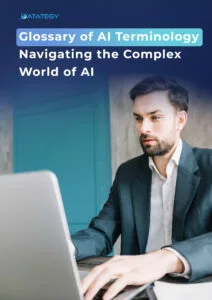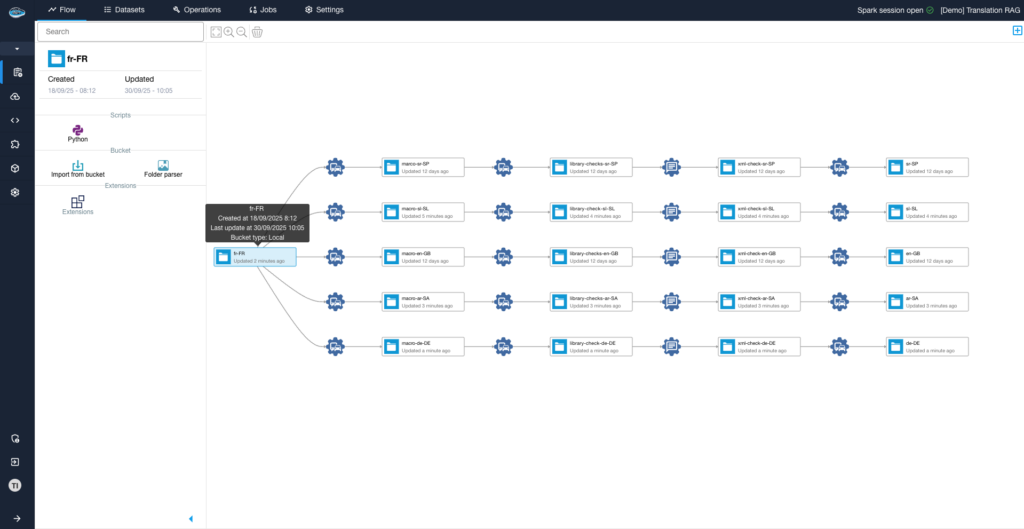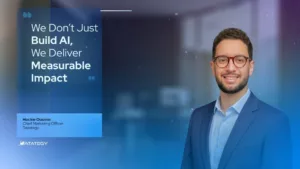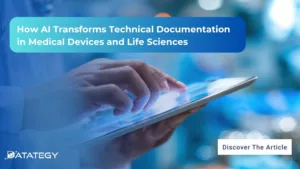We Don’t Just Build AI, We Deliver Measurable Impact Join...
Read MoreAI’s Role in Translating Complex Defence Documentation
Table of Contents
ToggleThe defence sector is experiencing a surge in innovation and transformation, driven by artificial intelligence. Specifically, internal data reveals a significant reduction in the deployment time of essential systems, partly due to advancements in the processing of important data.
Translating and quickly interpreting extremely complicated and sophisticated defence material is one of the most important uses of AI. The objective is to guarantee correctness and operational preparedness by overcoming linguistic obstacles and the inherent ambiguities of specialized jargon.

By 2025, the global market for document translation services is expected to grow to over $15 billion. demonstrating the enormous and expanding financial scope of the whole translation requirement, including the high-value defence sector. (Source: Datainsightsmarket)
This article will examine how AI is radically changing the speed and accuracy with which international defence forces can exchange and apply critical technological knowledge.
How is Technical Documentation Defined within the Defense Industry
Technical documentation in the defence industry refers to the extensive collection of comprehensive manuals, specifications, maintenance manuals, and operating procedures that explain the operation of intricate military equipment. These publications address everything from weapon platforms and communication networks to aircraft and radar systems.
They guarantee that every piece of equipment is utilized, maintained, and repaired in accordance with stringent standards by acting as a guide for engineers, technicians, and operators. The accuracy and clarity of this documentation are essential to mission success and operational safety because defence systems are frequently extremely complex and interdependent.
What are the Main Factors Contributing to the Growing Complexity of Defence Documentation?
1- Defence Documentation's Growing Scope
In recent decades, defence documentation has grown increasingly complex, mirroring the progress in military technology. Modern defence systems, such as aircraft, submarines, drones, and cybersecurity infrastructures, are now interconnected networks of hardware, software, and data, rather than standalone devices.
Each system requires thousands of pages of detailed documentation, including design specifications, operational guidelines, and maintenance schedules. As these systems evolve, their documentation must also adapt, leading to an ever-expanding body of technical material that must remain accurate, synchronised, and accessible to a wide range of stakeholders throughout the defence supply chain.
2- International Cooperation and Language Difficulties
The worldwide scope of defence initiatives adds to this complexity. Governments, vendors, and technology partners who operate in various languages, standards, and regulatory frameworks collaborate across borders on many projects. As a result, documentation needs to be linguistically and culturally consistent in addition to being technically accurate.
It is extremely difficult to translate highly specialized terminology while maintaining meaning between languages, especially when even little mistakes might have major operational repercussions. As a result, there is an increasing demand for processes that are precision-driven and capable of handling the language diversity and technical complexity of defence documents.
3- The Digital Transformation of Defense Documentation
New levels of complexity have been brought about by the digital revolution of defence. Documentation is no more static; it is constantly updated via digital platforms, connected to digital twins or predictive maintenance systems, and integrated with real-time sensor data. This implies that when missions and technology change, defence organisations have to handle dynamic documents.
It is now strategically essential to guarantee the traceability, security, and integrity of this data among geographically dispersed teams. Traditional manual methods are finding it difficult to keep up in this environment, opening the door for AI-driven systems that can efficiently handle, translate, and contextualise defence documents on a large scale.
Why are Conventional Translation Methods Insufficient in the Defence sector
1- Insufficient Connectivity with Digital Defence Systems
The digital ecosystems that defence organisations currently depend on are frequently disconnected from traditional translation tools and procedures. The majority of traditional translation systems are stand-alone programmes that cannot be connected to digital twin environments, logistical databases, or document management systems where real-time updates take place.
Because of this lack of compatibility, translations are frequently performed on static files, which soon become out of date when technical data changes. Teams must manually re-import, re-translate, and revalidate information in the absence of automatic synchronisation, which slows down operational preparedness and is prone to errors. This gap between digital processes and translation technologies makes it practically difficult to maintain an up-to-date multilingual knowledge base in highly dynamic defence contexts where modifications to aircraft systems or command software occur on a regular basis.
2- Incapacity to Manage Multimodal and Unstructured Data
The incapacity of conventional translation techniques to handle the many forms utilised in contemporary defence material is another significant drawback. Complex tables, schematics, infographics, code snippets, and even embedded sensor data are examples of defence information that is not limited to words. The majority of legacy translation operations are text-based, necessitating manual extraction and formatting prior to translation.
Particularly in safety-critical technical drawings or calibration tables, this manual preparation increases the possibility of data loss or formatting errors. Additionally, defence papers frequently combine many data formats, such as PDFs, XML, and CAD annotations, which conventional systems are unable to contextually analyse. Because of this, translators spend more time organising documents than concentrating on linguistic correctness, which leads to inefficiencies and a loss of quality in the finished product.
3- Security Concerns and Compliance Difficulties
Traditional translation operations frequently reveal serious weaknesses in the defence industry, which works in one of the world’s most security-sensitive areas. Multiple handovers between translators, reviewers, and subcontracted agencies are common in manual translation, which increases the risk of data leakage. Strict control is necessary for sensitive information like weapon specifications, tactical procedures, or confidential communications, but conventional approaches mostly rely on human judgment and secure file transmission, which is challenging to provide at scale.
It is logistically difficult to guarantee complete adherence to military-grade secrecy norms, even when employing verified translators. Furthermore, integrated compliance checks are absent from conventional translation systems. They do not automatically guarantee that translated information complies with defence procurement guidelines, interoperability requirements, or international export restrictions.
4- Poor Contextual Understanding and Accuracy in Complicated Technical Language
The whole context and technical accuracy needed in defence documents are frequently difficult to convey using traditional translation techniques, whether they are computer-assisted or human-only. Defence documents need a thorough grasp of both language and subject matter since they are extremely specialised, full of acronyms, domain-specific vocabulary, and complex engineering descriptions.
Operational manuals, maintenance instructions, and training manuals may contain potentially hazardous misconceptions due to human translators, even ones with technical expertise, misinterpreting minor subtleties or using inconsistent language. Furthermore, the defence industry depends on papers that must maintain consistency in tone, intent, and meaning—especially when handling procedural or safety-critical material.
What are The Most Common Technical Documents That Demand Translation by Field in Defence Sector
1- For Marine (Naval Forces & Maritime Security)
a- Maintenance and Repair Manuals
These manuals are essential to a warship or patrol ship. For anything from simple engine maintenance to intricate, urgent repairs on weapons systems or radar equipment, they include extremely detailed, procedural instructions. The technician on deck, who can be a member of an allied crew, must execute a faultless repair under extreme pressure when a breakdown happens during deployment.
A straightforward misreading of a warning label or a metric measurement might result in equipment failure, severe injuries, or the inability to finish the mission. These translated documents must maintain complete technical and terminological consistency across decades and languages to ensure operational continuity and sailor safety because naval vessels frequently have long service lives and complex, integrated systems that involve numerous international suppliers.
b- Naval Engineering Specifications and Architecture
These documents serve as a common language for engineers, designers, and manufacturers from several countries when they work together on shipbuilding, which is a regular practice due to the enormous expense and complexity.
They consist of comprehensive designs, material specifications, and requirements for regulatory compliance. Here, accurate translation is essential to maintaining structural and legal integrity. The vessel’s hull integrity, fire suppression, or combat capabilities might be jeopardised by any ambiguity in identifying a particular alloy, weld type, or tolerance level, producing long-term structural or safety hazards that are intolerable in a military setting.
2- For Air (Aviation & Aerospace)
a- Flight and Systems Manuals
These manuals, which specify the stringent protocols for operating, flying, and troubleshooting an aircraft, are sometimes regarded as the most important publications in the air domain. A pilot or member of the ground crew must act quickly and accurately in an emergency. The translated guidebook guarantees that an Italian maintenance staff and a German pilot flying the same type of fighter jet (such as the F-35 programme) adhere to the same safety-certified protocols. A mistranslated emergency checklist might result in the loss of a multimillion-dollar aircraft or, worse, the pilot’s life. These mistakes immediately translate into operational hazard.
b-Illustrated Parts Catalogs
Millions of separate parts, frequently sourced from around the world, make up modern aeroplanes. IPCs include replacement instructions, part numbers, and comprehensive diagrams. The maintenance notes and descriptive text must be carefully translated even though the component numbers themselves are universal to guarantee that the correct item is purchased and installed. The structural integrity or functional reliability of the aircraft is jeopardised if a maintenance worker uses the incorrect grade of bolt or performs a component swap incorrectly due to a translation error. This poses a serious risk during flight and causes significant delays in keeping the aircraft mission-ready.
3 Land (Ground Forces & Logistics)
a- User and Field Maintenance Manuals
The training of ground forces to fight, move, communicate, and coordinate the fundamental components of military art is described in these publications. The notion of interoperability in multinational operations depends on accurate translation of tactical doctrine, such that a Polish company commander and a U.S. platoon leader have the same understanding of phrases like “area of operations,” “hostile intent,” or “mission command.” In a dynamic combat scenario where milliseconds matter, a small mistranslation of a crucial tactical term might cause misunderstanding, friendly fire accidents, or mission failure by disrupting synchronisation between troops.
b- Logistics and Supply Chain Documentation:
The efficient flow of supplies, from food and gasoline to specialized spare parts and ammunition, is essential to the success of any military operation. Shipping manifests, procurement requirements, and comprehensive international contracts are examples of logistics paperwork. Here, translation guarantees that a manufacturer in one country will fully comprehend the technical specifications specified in a tender from another. A military unit’s capacity to continue operations over time may be severely hampered by mistakes in translating quantities, material requirements, or delivery deadlines, which can result in significant delays, legal issues, and the delivery of inaccurate, useless materials.

AI breaks down language barriers between allied forces, drastically accelerates maintenance cycles, and ultimately ensures that critical technical knowledge reaches the frontline and the factory floor with the speed and precision required for mission success.”
Eric Chau
CTO - Datategy
What are the Core Technologies of AI-Powered Technical Documentation Translation?
1- Neural Machine Translation (NMT)
The foundation of AI-powered document translation is Neural Machine Translation (NMT). NMT employs deep learning models that simulate how the human brain interprets language, in contrast to conventional systems that depended on strict rules or phrase-based matching. It analyses whole phrases, extracts meaning from context, and generates natural-sounding, fluid translations.
By processing words in parallel rather than sequentially, NMT models like Transformer topologies (such as Google’s BERT or OpenAI’s GPT-based systems) substantially improve translation quality. They are better able to understand technological subtleties and long-range relationships as a result. In order to guarantee that translations maintain the integrity of specialised terminology, several businesses train domain-specific NMT models that are suited to industries like engineering, software, or medical equipment.
2- Natural Language Processing (NLP)
AI translation engines can “understand” text instead of just processing it thanks to natural language processing, or NLP. It is the area of artificial intelligence that deals with language understanding, or how words interact to express connections, thoughts, and feelings. By analysing phrases’ purpose and contextual relevance in addition to their literal meaning, natural language processing (NLP) improves translation accuracy.
NLP is essential for translating technical documents. It examines word meaning (semantics), sentence form (syntax), and even terminology unique to a certain topic (lexical semantics). For instance, the term “charge” may be used to describe a financial charge in accounting or an electrical charge in engineering. Contextual cues are used by NLP models to identify which sense is appropriate for the topic of the document.
3- Translation Memory (TM) and Terminology Management Systems
In essence, a Translation Memory is a dynamic database that keeps authorised translations of previously translated phrases, sentences, or paragraphs. The AI engine automatically reuses matches when a new document is analysed by comparing its content to the TM. This method ensures linguistic consistency across several projects while saving time and money.
Conversely, dictionaries of authorised technical words, brand names, and acronyms are kept up to date by terminology management systems. For instance, an aerospace business may define “torque converter” or “rotor blade assembly” in a certain way; the TMS makes sure these terms are translated uniformly into each target language.
4- Machine Learning and Quality Estimation
The self-improving foundation of AI-powered technical translation is machine learning (ML). ML systems continually evaluate data from previous translations, user input, and error fixes in place of static rules to improve future performance. Similar to how a human translator gains expertise over time, this feedback loop enables translation engines to learn and develop.
This adaptive learning is very useful in technical documents. Each sector has its own compliance regulations, formatting standards, and lingo. These details are learned by ML models, making translations more precise with each job. For example, if engineers modify a translation for “valve assembly” in a mechanical handbook on a regular basis, the AI system logs this preference and automatically applies it in subsequent translations.
What are The Benefits of Using AI in Technical Documentation Translation in Denfece Industry
1- Improved Accuracy and Consistency
In defence documents, accuracy and consistency are crucial since even little translation mistakes can have serious operational, safety, or strategic repercussions. Conventional translation techniques mostly depend on individual skill, which might differ between translators, languages, and document revisions. Documents in highly technical subjects, such as defence, include acronyms, context-dependent instructions, and specialized vocabulary that must be interpreted precisely.
By utilizing machine learning models that have been specially trained on defence terminology and technical material, AI-powered translation systems overcome this difficulty. These models are capable of identifying appropriate technical terminology, analysing sentence context, and guaranteeing that meaning is maintained across languages.
2- Enhanced Integration with Digital Workflows
Defence documentation has developed into a sophisticated digital environment rather of being limited to printed instructions. Digital twins, collaborative knowledge bases, predictive maintenance tools, and document management systems are examples of modern platforms. This digital transformation is too fast for traditional translation operations, which are frequently isolated and manual. Conversely, these workflows are easily integrated with AI-powered translation systems, which allow for the automated synchronisation of translated information with real-time changes.
Engineers, operators, and allied troops always have access to the most recent documents because to integration. For instance, AI translation systems may automatically identify changes, translate the new text, and update all language versions when a technical method is altered in a central repository.
3- Faster Turnaround and Scalability
In modern defence operations, where teams must get changes to equipment manuals, maintenance protocols, or operating rules instantly, speed is crucial. Conventional translation processes are sluggish, especially when there are several languages involved or a large number of documents. By analysing massive amounts of material at once and producing translations far more quickly than human-only techniques, AI-powered translation technologies get beyond this restriction. This quick turnaround guarantees that defence teams always have access to current information without any delays that can jeopardise operational effectiveness or preparedness.
Another important benefit is scalability. Global cooperation involving several countries, manufacturers, and contractors is a feature of contemporary defence programmes. To ensure cross-team compliance and interoperability, a single update could need to be translated into dozens of languages. AI systems can easily grow to meet these expectations.
4- Assistance with Complex and Multimodal Data
It is difficult to translate defence documentation using conventional techniques since it increasingly contains a combination of text, diagrams, tables, CAD comments, schematics, and sensor data. Before translating, human translators frequently have to manually remove or reformat text, which is laborious and error-prone. However, multimodal material may be processed contextually by AI-powered systems, which are able to comprehend complicated data formats’ structure and meaning in addition to their language.
For instance, AI can properly express all important information by translating language incorporated in technical diagrams, maintaining table integrity, and even interpreting notes in CAD files. This skill is essential for mission readiness and operational safety since misreading tables or diagrams can result in improper maintenance practices, malfunctioning equipment, or delays in operations.
+ Better Compliance and Security
In the defence industry, where technical documentation frequently contains sensitive, classified, or restricted information, security and compliance are crucial. Due to the numerous human touchpoints involved in traditional translation processes, there is a higher chance of data breaches, illegal access, or procedural mistakes. Sensitive defence papers are safeguarded during the translation process thanks to AI-powered translation systems’ enhanced security features, which include encrypted workflows, restricted access, and automatic compliance checks.
Incorporating AI into the translation of technical defense documentation provides a massive cost reduction of up to 10 times over traditional human-only processes, as proven by Datategy’s specialists. This significant gain is directly tied to improved security and compliance protocols. AI automates the bulk of translation work, drastically limiting the exposure of sensitive technical data across multiple manual touchpoints.
Demystifying AI: A Comprehensive Guide to Key Concepts and Terminology
This guide will cover the essential terminology that every beginner needs to know. Whether you are a student, a business owner, or simply someone who is interested in AI, this guide will provide you with a solid foundation in AI terminology to help you better understand this exciting field.

How Datategy Enhances AI-powered Technical Documentation Translation
OmniRAG, a sophisticated Retrieval-Augmented Generation system that goes much beyond conventional translation, is at the core of papAI Translate Suite. To determine the actual context of a document, OmniRAG cross-references existing manuals, technical information, and domain-specific glossaries rather than translating text word for word.
This implies that each translated sentence is consistent with the original engineering purpose for technical documents, where accuracy is crucial. papAI guarantees semantic correctness and terminological consistency when translating complicated aeronautical protocols or DITA/XML manuals for advanced systems. This context-driven translation minimises the possibility of misunderstanding, which is frequently an expensive problem in multilingual industrial settings, and significantly cuts down on human post-editing time.

Key figures
Here’s an in-depth look at the key features and advantages of this innovative solution:
1- Preserving Complex Document Structures and Metadata
Unlike general translation APIs, papAI Translate Suite was designed specifically for mission-critical document formats including XML, DITA, XLIFF, CSV, PDF, and Microsoft Office files. The platform’s format integrity ensures that every technical document’s contents, structure, and tags are maintained during translation.
This guarantees that translated outputs remain fully compatible with content management systems (CMS) and writing tools used by technical writers, engineers, and manufacturers. By avoiding formatting problems that might impede procedures by maintaining metadata integrity and structural hierarchy, PapAI guarantees that translated papers are instantly ready for publication, compliance review, or integration into automated pipelines.

2- AI-Powered Quality Assurance and Terminology Contro
A Multi-Agent Quality Assurance (QA) layer in the papAI Translate Suite automatically confirms translation quality in a number of areas. This system detects possible translation mistakes for rectification, verifies tag consistency, and harmonises language across product lines. The end product is an industrial-grade QA loop that preserves complete linguistic and technical coherence while lowering the manual review burden. This implies speedier worldwide release cycles without sacrificing accuracy or compliance for businesses that oversee sizable multilingual repositories, such those in the automotive, industrial, or energy sectors.

3- Continuous Learning and Integration at Scale
Through its reviewer feedback loop, papAI Translate Suite is always evolving. Future translations are strengthened by reinjecting each human correction, whether from a linguist, engineer, or compliance officer, into the AI model. papAI gradually adjusts to the distinct technical jargon, product nomenclature, and regulatory tone of an organisation.
Furthermore, adherence to data governance rules is guaranteed by its scalable and independent architecture, which may be deployed on OVH, Scaleway, or on-premises. PapAI is a plug-and-play solution for businesses looking to automate multilingual documentation without compromising security, accuracy, or contextual intelligence thanks to integration-ready APIs and native CMS integrations.

Leverage papAI’s AI Capabilities to Revolutionize Defense Technical Documentation Translation
Using AI for documentation translation is now necessary as defence operations grow more linked, global, and technologically sophisticated. Teams may use papAI to save expenses and human labour while streamlining multilingual communication, maintaining compliance, and accessing real-time information.
Every document is guaranteed to satisfy the high standards necessary for operational readiness and mission-critical accuracy thanks to the platform’s capacity to learn from previous translations and intelligently adapt.
Book a demo with papAI and experience firsthand how our AI-driven translation capabilities can elevate your technical documentation, improve operational efficiency, and empower your teams across languages and borders.
Traditional methods often struggle with accuracy, consistency, and speed when handling complex, technical content. Human translators may misinterpret specialized terms, and workflows are slow, expensive, and difficult to scale, particularly for multilingual and rapidly evolving defense materials.
Defense documentation is highly specialized, often containing intricate technical specifications, acronyms, operational procedures, and safety-critical instructions. It also spans multiple languages and formats, including text, tables, diagrams, and CAD annotations, making it challenging to maintain accuracy, consistency, and contextual meaning across all materials.
Unlike traditional methods, AI can process text alongside tables, diagrams, schematics, and CAD annotations. This ensures that all content—textual or visual—is accurately translated and preserved, minimizing errors and supporting operational efficiency in mission-critical contexts.
Modern AI systems connect seamlessly to document management platforms, digital twins, and knowledge bases. This integration allows real-time synchronization, automated updates, and centralized version control, ensuring translated content is always accurate, up-to-date, and easily accessible to all teams.
Interested in discovering papAI?
Watch our platform in action now
AI’s Role in Translating Complex Defence Documentation
AI’s Role in Translating Complex Defence Documentation The defence sector...
Read MoreHow AI Transforms Technical Documentation in Medical Devices and Life Sciences
How AI Transforms Technical Documentation in Medical Devices and Life...
Read MoreDatategy and Alpha X Join Forces to Strengthen AI-Driven Governance Across EMEA
Datategy and Alpha X Join Forces to Strengthen AI-Driven Governance...
Read More




